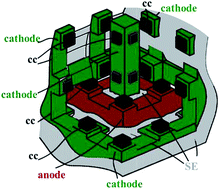Towards smart free form-factor 3D printable batteries
Abstract
Continuous novelty as the basis for creative advance in rapidly developing different form-factor microelectronic devices requires seamless integrability of batteries. Thus, in the past decade, along with developments in battery materials, the focus has been shifting more and more towards innovative fabrication processes, unconventional configurations, and designs with multi-functional components. We present here, for the first time, a novel concept and feasibility study of a 3D-microbattery printed by fused-filament fabrication (FFF). The reversible electrochemical cycling of 3D printed lithium iron phosphate (LFP) and lithium titanate (LTO) composite polymer electrodes vs. the lithium metal anode has been demonstrated in cells containing conventional non-aqueous and ionic-liquid electrolytes. We believe that by using comprehensively structured interlaced electrode networks it would be possible not only to fabricate free form-factor batteries but also to alleviate the continuous volume changes occurring during charge and discharge.



 Please wait while we load your content...
Please wait while we load your content...